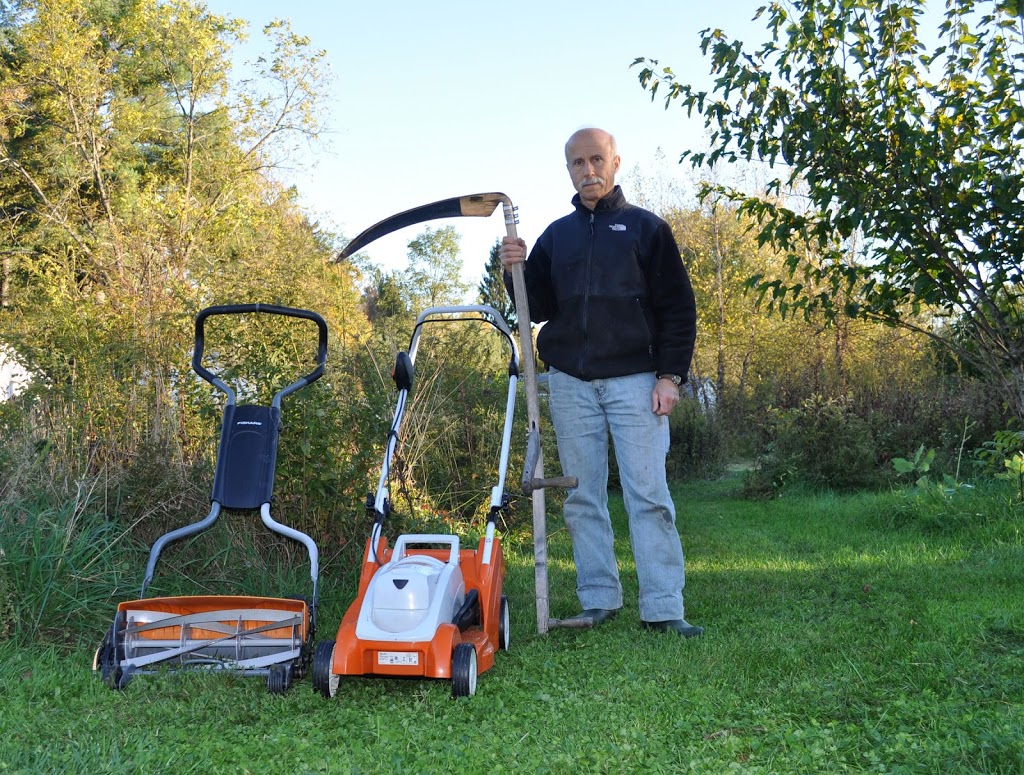TO MOW OR NOT TO MOW, THAT IS THE…
Cooler weather and moister conditions are keeping the lawn happily lush, and still growing. I figure we’ll need to do one or two more mowings before the season ends. That is, unless you count yourself a member of the anti-lawn movement.
The vendetta against lawns is two-fold. First, those lawn areas could be used for growing food. “Food not lawns” is the calling cry (and the website, www.foodnotlawns.com) for those who have repurposed their front and/or back yards for food production. And second, lawns often are ecological disasters, especially those maintained lush and weed-free no matter what the summer weather. But even a lackadaisical lawn needs regular mowing, or it becomes something other than lawn. One hour of mowing with a gasoline-powered mower spews as much fumes into the air as does driving a couple of hundred miles.
I choose a middle ground, and enjoy the appearance, the convenience, and feel of some well-placed turf. Many years ago I gave over some of that lawn to growing all our vegetables and much of our fruits.
My original property of 3/4 of an acre has grown to almost 2 and a half acres, much of it was once regularly mowed (by previous owners). I originally maintained it with a scythe but have since acquired a tractor for giving most of the fields once-a-year haircut, with more frequent cutting around orchard and vegetable gardens.
————————————————-
But just suppose I had a smaller property, a much smaller property, say 1/8 of an acre with a smooth lawn. An environmentally-friendly and pleasant option for this lawn would be a push mower. Newer materials and newer engineering bumped weighty, clunker push mowers of yore into modern sleek, lightweight grass eaters.
An excellent choice among the many push mowers offered today is one of Fiskars Reel Mowers. They’re relatively easy to push and sing a pleasant tappity-tap beat as they roll along spewing cut grass in front.
The only caveat with a push mower is that mowing grass that has grown too long is very difficult. The solution? Mow frequently enough. It’s also better for the grass.
————————————————-
No need for the roar of exploding gasoline for a bigger lawn. For three-quarters of an acre, perhaps more, I’d opt for an electric mower, a cordless one. Battery technology has greatly improved in recent years, giving contemporary cordless mowers a lot more power and longer running times.
My choice among these mowers is Stihl. The cutting width is a bit narrow but the mower is extremely light and very spry to push around. With a mere push of a button and squeeze of a bar needed to start it, this mower won’t make you give a second thought to stopping to move a lawn chair or dog bowl out of the way. This mower plows through even long grass. Run time is 25 minutes on a charge but charging (with the more expensive of the two chargers available) takes only 45 minutes. Take a break; have a cup of tea.
The Stihl mower has just one downside: price. The mower, the battery, the charger, and the mulching attachment (better for the lawn) require a hefty layout of hundreds of dollars. But think long term. When you consider the cost of running and repair, over the long term this mower is cheaper to run than a gasoline-powered mower. And it’s a lot quieter and lighter.
————————————————-
An even bigger lawn? A larger area, even a few acres, can be eco-friendly by converting it to what I call, in my book The Pruning Book (which has a chapter on “pruning” grass), “Lawn Nouveau.”
With Lawn Nouveau, you sculpt out two layers of grassy growth. The low grass is just like any other lawn, and kept that way with, depending on the expanse of low grass, either the push mower or the cordless electric mower. The taller portions are mowed infrequently — one to three times a year, depending on the desired look. “Clippings” from the tall grass portions are good material for mulch or compost.
A crisp boundary between tall and low grass keeps everything neat and avoids the appearance of an unmown lawn. That boundary itself becomes a landscape element. No need for straight edges and 90° corners; instead, carve out curves in bold sweeps that can carry you along, then pull you forward and push you backward, as you look upon them. Avenues of low grass cut into the tall grass invite exploration, and, like the broad sweeps, can be varied from year to year.
That tall grass portion could be mowed with a tractor, but more fun and better for the environment is to use a scythe. Not just any old scythe, though, surely not those heavy, dull ones you sometimes find at garage sales. I use a lightweight, European-style scythe with a razor-sharp “Austrian blade.” Scything in early morning (the swooshing of the blade doesn’t disturb neighbors) when the grass is dewy on the outside and plump with moisture inside, plant cells practically pop apart when touched by the sharp blade.
Quoting one-time Congressional candidate, homesteader, and swinger of a scythe into his nineties, Scott Nearing: “It is a first-class, fresh-air exercise, that stirs the blood and flexes the muscles, while it clears the meadows.” And helps maintain Lawn Nouveau.
———————————————-
So there you have it: Three expanses of grass to mow; three environmentally friendly tools for the job. The push mower (Fiskars), the cordless electric mower (Stihl), and the scythe (available from www.themaruggcompany.com/index.html and www.scythesupply.com).




